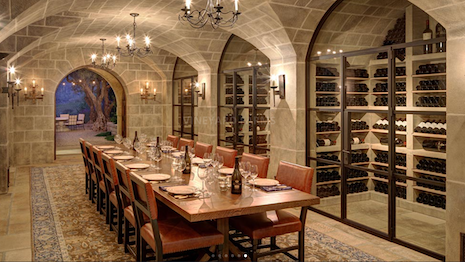- About
- Subscribe Now
- New York,
November 5, 2020

 Design as a category, once proud of its democratization, is now its victim. Image credit: Jim Murphy & Associates
Design as a category, once proud of its democratization, is now its victim. Image credit: Jim Murphy & Associates
The continued expansion of wealth over the last 15 years should have been positive for all who serve the affluent. But that is not what happened.
The evolution of technology and the democratization of almost everything has not treated every category fairly. The trap was set for some industries to falter.
Shape of things
Design as a category, once proud of its democratization, is now its victim.
Increasingly, design firms are moving to the luxury business model.
Luxury is misunderstood. It is not about price of the service/product. Luxury is a business model with specific laws that drive desire for your brand. Consumer trends change and technology evolves. Luxury is a constant.
The traditional design business model is broken. Television networks, the abundance of pseudo-expert information, new competitors selling knockoffs, platforms selling design services coupled with the diminishing relevance of magazines and design centers have all contributed to parity that is not sustainable.
To grow in our rapidly changing world, design professionals and resources have to escape the design business model and adopt the luxury business model. Enlightened professionals see the light.
The luxury business model has specific laws. I have outlined many of them in reference to design, but they transcend all categories.
The first law in luxury is a marketing first’ business model.
Design professionals who wish to serve more HNW families will have to adopt the luxury business model and become proactive marketers.
Luxury is driven by marketing that creates desire for your brand. The result is more clients, higher margins and increased brand equity.
The most dangerous myth in design is that design professionals are somehow above marketing. If Louis Vuitton, Chanel, Cartier and Patek Philippe must advertise, then so do those in design.
No firm can escape market forces.
Expecting referrals to drive revenue growth is naïve. Worse, it is absurd to think your firm’s future is dependent on somebody else saying something nice about you. This is particularly true considering the wealthier your client, the less likely they are to refer anyone or allow you to share images of their residence.
Marketing drives brand awareness and design. Anonymity, whether deliberate or not, is poor strategy. Void of brand, design will continue to be dumbed-down and commoditized.
Exclusivity is the second law of luxury.
Design is inclusive, meant for all. Luxury is decidedly not meant for everyone. There is no value-engineering in luxury to expand a client base.
The quality of a product or service is non-negotiable.
While many in design are exploring less expensive strategies to meet price points, luxury is committed to the preservation of craftsmanship and artisanship.
Luxury is not meant to be affordable. Higher prices are an asset.
Scarcity for design resources and designer loyalty are the next two laws of luxury.
Design resources, like luxury brands, have historically limited their distribution.
Designers who break the law of loyalty by shopping online or at various retailers, are putting one of their most valuable assets at risk: loyal private resources.
The next logical step is happening now. Design showrooms are moving to retail locations where designers are regular customers like everybody else.
When this happens the design distribution channel collapses and the value proposition for interior designers will change dramatically.
Scarcity is important when you align your brand with a platform or association, too.
To consumers, an increasing number of participants means lower standards. You become one of too many, with no benefit to your brand.
The fifth law of luxury is provenance.
From whence an object is made matters.
A large percentage of luxury products are manufactured in Europe and the United States.
Each country is its own brand representing excellence in specific categories. You can buy stone from Italy or a similar looking stone from Central America. The latter is less expensive.
But knockoffs are an embarrassment in luxury and should be to your affluent client.
I was invited to visit a kitchen showroom in a Western design center. The owner impressively treated the product as a connoisseur highlighting each special detail. But the cabinetry was from Asia, hence it could not be luxury. Luxury cabinets do not come from Asia.
A corollary in the automobile industry is Genesis by Hyundai where its landing page claims the car “will make you rethink everything you thought you knew about luxury.” No, it will not. Genesis is from South Korea. Luxury cars do not come from South Korea. Provenance matters in luxury.
The sixth law is luxury brands are defined by the brands with whom they associate.
When design brands advertise in local yokel publications, they are telling readers they are a local yokel, too.
Few HNW individuals want a designer who is a local yokel. Where you resource product matters. You elevate the importance of your firm when you specify product from trade resources.
Association matters because, in luxury, your brand is sacred: this is the seventh law.
While marketing, locating your studio or showroom, or allowing your brand to be presented on the appropriate platform is essential. Be judicious in where you’re found. Every touch point matters.
In the luxury business model, being superlative is the eighth law.
Luxury brands have no competition because the brand DNA and point of view are unique.
A Chanel client is different from a Cartier client, as a Mercedes client is different from an Audi client.
Designers who fully adopt a luxury business model will not compete with other designers for clients.
Luxury brands have narratives. They tell stories through each touch point. This is the ninth law of luxury.
If you are buying a handbag at a Chanel boutique, you will certainly hear the story of the hidden place where Coco kept letters from her lovers.
Visiting most design showrooms is a very different experience. Generally, product is lined up row after row.
Luxury brands understand their transactions are driven by emotion and intangibles, not pretty product. It is the same online.
Most design Web sites are created like catalogs with pages of tables, sofas and other products waiting to be sold, while luxury brand Web sites are romantic and filled with stories.
In luxury, what you produce is not what your clients buy.
Luxury is outward-looking to serve clients far beyond product, while design tends to be inward focused on product. The differences are stark – and so are the results.
Luxury brands are superlative, with higher standards, specific narratives and a point of view that is entirely their own – the tenth law of luxury.
Designers and decorative resources with a point of view who are connoisseurs of their category and embrace the luxury business model are actively elevating their brand to where they have no competition.
The current design business model and bubble promote parity. I liken it to Garrison Keillor’s fictional Minnesota town where “all the children are above average.”
I often ask designers about their decorative point of view. The vast majority tells me they do what the client wants. This is unfortunate. Because, if true, then the client need only hire a design student who listens well.
A luxury firm’s point of view is integral to its value proposition. Otherwise it is a price or personality contest.
The eleventh law of luxury is transparent pricing that builds trust. There are never surprises.
When quoting price, luxury brands ensure all costs are included, including enough for 12 percent to 18 percent of cost of sales for marketing.
Luxury brands have higher margins and discounting is frowned upon. The price is inherently higher because standards are higher, and luxury purveyors are proud, not fearful.
Price stability and transparency manifesting trust are essential. There are no surprises.
Research tells us that people inherently believe if something is more expensive, then it is a superior product. And it is superior if your brand has embraced the laws of luxury.
My experience is that interior designers too often create pricing structures that are confusing and filled with variables. Simplify.
Luxury brands manage each cost and present one fair price. They make it easy because that is how affluent clients want it.
Price is part of your value proposition and a sense of pride, not a variable. Luxury is not meant to save anyone money.
The final law of luxury is being discreet and private, and acting with grace and sophistication.
Luxury brands mind their manners as they are the keepers of humanity.
Unity Marketing, who along with The Home Trust, sponsors Luxury Daily’s annual State of Luxury research, taught us that high-net-worth consumers do not want their designers to be seen all over social media. In their eyes, it demeans the designer’s brand and practice.
The divide between social media and advertising is wide, according to research.
Most HNW families live private lives and they expect those who serve them to be private, too. It is why credit card companies give UHNWIs credit cards with aliases. It is why estate managers are insulted if you ask the name of their principal.
In luxury we serve our clients by respecting their values by being private and discreet, graceful and sophisticated.
DESIGN RESOURCES AND high-level design professionals are at an inflection point.
Currently, every brand is a technology brand, and every brand is either predator or prey. Moving to the luxury business model is the natural evolution of survival.
Good taste and design, like service, quality and craftsmanship, are a given in luxury.
Each law of luxury is intertwined. Yet nothing matters if you do not market aggressively to drive desire for brand.
For select interior designers and majority of design resources, adopting the luxury business model is key to ensuring financial success in our technology-fueled commoditized environment.
I will finish with a quote that I often use to open my keynotes. It is from The Leopard written by Giuseppe di Lampedusa: “If we want things to stay as they are, things will have to change.”
 Chris Ramey is president of The Home Trust
Chris Ramey is president of The Home Trust
Christopher P. Ramey is president of The Home Trust International, Palm Beach, FL. Reach him at cpr@thehometrust.com.
Share your thoughts. Click here